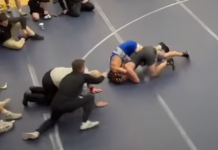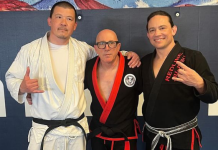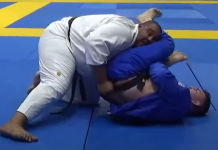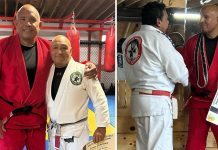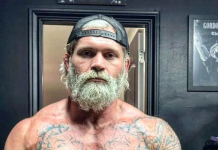For jiu-jitsu beginners discovering the wonders of BJJ YouTube for the first time, there’s a solid chance they’ve stumbled across a Chewjitsu video or five.
In a growing sea of MMA- and BJJ-themed YouTube content, black belt jiu-jitsu coach and gym owner Nick Albin’s “Chewjitsu†channel is among the most popular by miles. The channel boasts north of 310,000 subscribers, and most videos attract views into the tens of thousands. It’s been a great way for Nick – better known as “Chewy†in the grappling community – to grow his primary business: running his gym, Derby City MMA. However, that wasn’t necessarily at the top of his mind when he started the channel.
The actual origin of the YouTube channel was an old blog that Chewy launched in 2012. “At the time, that’s what everybody was doing,†he explains to me, chuckling a little. “So I thought, ‘Hey, I’ll do a blog too!’†Over time, he started making videos to go along with the blog – and more importantly, he’d record videos for his students, usually on the technique of the week, or a set of related drills.
He’d always loved videos as a medium, and actually made his first attempt at recording one back in 2009, focusing on gi reviews. “If anybody’s ever tried recording a video, you have been surprised that you’re not able to speak as smoothly as you do regularly,†he points out. “Because you’re staring at this mechanical eyeball, and there’s no feedback from another human, so it doesn’t feel very natural.â€
Unsurprisingly, his first video wasn’t stellar. “I tried to speak in front of the camera, and at the time I wasn’t a very polished speaker to begin with – and in addition to that, I just wasn’t very comfortable in front of the camera – so the video came out terrible,†Chewy recalls wryly. “And I remember my girlfriend at the time just hysterically laughing at me, and talking about how terrible this was.†As you might imagine, this did not particularly encourage Chewy to continue his budding videography efforts.
That love of video itself persisted, though. He describes his drive to return to recording as an “itch†that eventually overcame that first blush of embarrassment. “Once I was in the gym, that’s when I really got back into doing the videos,†he explains. “I was kind of doing them at the same time – but I was a full-time coach-slash-gym owner, before I was a YouTuber.â€
“I have a group of about fifty students that do business stuff with me, and I remember talking to one of them about my gym, and he went, ‘Oh, but it’s easy for you, because you’re this YouTuber guy, so whatever.’ And I kind of had to remind him that I was a successful coach and a successful gym owner before I ever became a YouTube guy. Our gym was already bumping, and we already had 300 plus students, well before I ever had the YouTube channel.â€
That said, the popularity of his YouTube channel has blossomed concurrently with the growth of his gym. “People find me, and they know what I’m about, and they’re like, ‘Oh, cool, I’m gonna go train with this guy!’†says Chewy. “Just like anybody else, if you find something you’re interested in, what are you going to do? You’re going to search the Internet to try and find out more about it. So people would find our gym, and they’d research the gym, they’d find me, and they’d go, ‘Cool, I get to train with this guy and his students, sounds good to me!’
“So having that YouTube presence has definitely increased enrollment and made that process much easier – but at the same time, running the YouTube channel and running the gym do work hand-in-hand together.â€
While he doesn’t have exact figures on how much growth at Derby City MMA is driven specifically by YouTube views, Chewy does have countless anecdotes about students who have walked in because they recognized him from his channel, and wanted to train with the guy whose content had shaped their jiu-jitsu practices from afar.
“In direct response marketing, where say, you run an ad, and someone signs up or buys a product, I can see where it came from, and I can measure exactly how much it costs,†Chewy tells me. More general content creation – like the YouTube library – is a different story.
“With general content, you’re dealing with a lot more intangibles,†he explains. “People might be watching you for months before ever coming in. So it’s hard to say what the exact numbers are, but it’s obviously had a very nice impact on the gym, where it’s definitely been positive. But it’s also one of those things where it’s very hard to measure. So I couldn’t give you an exact figure, per se, but our business has definitely increased in a large way since the gym and the YouTube channel have been working together synergistically.â€
One of Chewy’s biggest tips when it comes to video content creation is making sure that you’re keeping your audience in mind. “If you’re going to make video content, it shouldn’t be for you. And what I mean by that is that you might enjoy the content, but it’s not for you, it’s for the person watching it. So when I make videos, I’m not making the video for me – I’m making it for the person watching it. The person watching it may be a brand new white belt, so this question that they’re asking me seems very simple, but when I was a white belt, I probably had the same question – so I just want to answer it as best I can.â€
How did he feel about the process of monetizing the Chewjitsu YouTube channel? “Everybody wants to make a little extra money,†Chewy admits. “I’m kind of weird though – money’s not a very good driving force for me. If I’m taken care of, I become very complacent if my only driving factor is money. More money to get more money just isn’t my thing.†He smiles. “I come from very humble beginnings, so I don’t have extravagant tastes.â€
“I just looked at [the YouTube channel] as a way to get some extra money coming in that could potentially fund stuff like competition teams, to help support more coaches in the gym, and to fund a little bit more of a retirement down the road. I kind of looked at all those things, but I did [the YouTube videos] because I liked doing it.â€
“If making the videos was simply just a job, well, I’ve got a full-time job, so I don’t need another one. But I still, do this day, enjoy doing it,†he adds. “I remember talking to another YouTuber, who asked me if I ever get burned out – because he was feeling burned out. And I went, ‘No, I enjoy doing this. This is fun! I get to talk out ideas with people, and share different stuff; what else would I do with my life?’ I find it to be a very pleasurable way to make a very good income.â€
In fact, Chewy’s primary piece of advice for emulating his success comes down, in large part, to enjoying what you do. “What I do is a lot of work, and it exhausts me sometimes,†he admits. “But I enjoy it in the end, and find it meaningful, and therefore, I don’t mind doing all that work.â€
I finally got a chance to meet Chewy in person a few months ago, when I took myself to one of his famous Costa Rica training camps over the summer. It was pretty evident to me from the get-go that he practices what he preaches: from designing a camp curriculum that’s friendly for all levels, to collaborating with Hero Academy retreat whiz Ron Jarman to ensure that students have some off-mat fun as well, Chewy really, truly loves his work – and that love pays dividends for his students.
“Some of [what I accomplished in my career] was by design, and some of it just happened,†Chewy tells me. “I think that’s often how it works – if you want to think of it as a jiu-jitsu match, you go in with a game plan, and sometimes the game plan works, but a lot of the time, only some of the game plan works, and then you have to adapt to whatever happens afterwards.â€
For example, he knew for years that he wanted to teach jiu-jitsu for a living. It wasn’t until later that he became more interested in the business-building side of his teaching career. “I had to become a student of business,†he says. “I had to study it like I study anything else related to jiu-jitsu. I had to really dive into it, and that led me down some crazy rabbit holes which completely flopped and didn’t work at all – but also some stuff that worked really well.â€
“Most of our successes are built on a big pile of failures – and we understand that when it comes to our training, but not always when it comes to our business,†he says. “It’s really the same – the business mistakes are somewhat costly, but it’s really useful.â€
What’s one example of a failure? Chewy laughs. “One of the first mistakes I made that was a big blow-up happened in 2010. I went to a UFC gym in Nashville, and there was a guy who was running a big gym, and they were making big money back then. They were doing direct-to-gym gis, and they had a tour bus running around town giving out DVDs, so later on in that year, I thought, ‘We’ve got to do something like that!’
“One of our students was a video guy, so he recorded this little promo video that was really in-your-face, very ‘check out how cool we are’ – but it didn’t have a good call to action, and it didn’t tell a story about why this would be useful for other people. It was just cool for us, and bumping our ego up, but it unfortunately had nothing to do with the customer.
“So then we’d get these DVDs made, and one of our guys was involved in a fraternity, so he got these girls from sororities – especially because our main market back then was men between the ages of 22 and 32 – so, we got these attractive women who ran around wearing shirts that said ‘Free DVDs’ and handing out DVDs. We thought it was going to work out great.â€
Spoilers: it did not, in fact, work out great. “The next week, we got almost nothing,†recalls Chewy. “No one ever came into our gym and said, ‘Hey, I got one of those DVDs,’ even though we gave out thousands of them.â€
There’s two mistakes worth learning from here, according to Chewy. “One, you don’t want to follow what everyone else is doing,†he says. “There’s lessons to be learned from what other people are doing. But in video content creation, for example, you’ll often see people just doing whatever other people are doing.
“Back in the day, Kurt Osiander was one of the biggest YouTubers in the BJJ space, and he always did a technique of the week, so you saw a whole mess of other YouTubers doing a technique of the week. They’d do it for a couple weeks, and then they’d just quit – because they didn’t enjoy it. That wasn’t their thing; that was Kurt’s thing. And they were doing someone else’s thing, and expecting the same results.â€
“Two, do something that actually interests you – and if it doesn’t interest you, don’t do it,†Chewy advises. “Because it goes back to doing something you enjoy. It’s a very tough road, doing any of this stuff, so if you don’t really enjoy it, it’s probably not the right thing for you.â€
Growing pains and tough lessons aside, though, Chewy’s business has flourished – and that’s due in large part to his continual willingness to learn. “There’s plenty of money to be made in the jiu-jitsu industry,†he tells me with frank honesty. “People say that there’s no money to be made, but that’s just people who don’t know what they’re doing. Simple. The problem is that people are looking for the answer, but they don’t look anywhere else besides [the example that other people have already set].â€
“When you look at a lot of jiu-jitsu gym owners, you see that they’re broken physically, broke financially, and kind of just getting by,†he elaborates. “So looking at that, I thought, ‘Well, I don’t want to do that.’ Which then led me to ask, ‘Well, what are other ways of doing stuff?’†Instead of modeling himself on other BJJ gym owners, Chewy looked outside of his immediate industry. He studied other thriving small businesses. He tried to figure out what drove their success.
One example he cites is the amusement park model. “When you get off of a ride, where do you go? Where does it send you? If you go to Disney World, for example, when you get off the ride, you go into a gift shop. And you buy stuff, right? And people spend outrageous amounts of money at Disney World, and they’re happy about it.â€
Chewy adapted that same model for his jiu-jitsu gym: “We used to have our pro shop over in the corner – didn’t have much stuff going on, didn’t have a lot of inventory, and we never made a lot of money off it. So we simply got more stock, more inventory, and put it right smack dab where you walk in and walk out of the gym. Every time you walk in and walk out, you see it and think, ‘Hey, I might want to buy something.’ It’s not a pressure tactic – it’s just, ‘Hey, we have stuff for sale, in case you’re interested.’
“And when people visit, when people come and train at the gym, when the students are there – that one little thing makes a five figure difference. Like, well into mid five figures, every year, just from putting T-shirts and shorts for sale in the right location. And it’s a very simple idea, but I didn’t know any better when I first started out.â€
For all that he doesn’t consider himself especially money-driven, and encourages genuine love for your work, Chewy also cautions against eschewing money in favor of passion. “You cannot have a poor relationship with money,†he emphasizes. Over the years, he’s observed a trend in the jiu-jitsu community of athletes who treat money as “an icky thing,†believing instead that jiu-jitsu should run on nothing but the purest love for the sport.
That, of course, is less than realistic.
“Money is just energy, and it has the ability to do beautiful things,†says Chewy. He’s learned as much firsthand. Money has enabled him to employ coaches full-time, and pay for their health insurance benefits. Money has enabled him to cover his students’ competition travel fees. Money has enabled him to host seminars from superstars of the grappling world – like JT Torres, for example – and offer the experience free of charge to Derby City MMA students.
“One of the things I always wanted to do was make sure we never strayed to the point where we abuse our relationship with our students,†adds Chewy. “I never want them to feel like a dollar sign. I want them to feel like very valued members, which they are, and I want to take care of them.â€
At the end of the day, Chewy sets his business up for success by investing in his people. Instead of spending extra cash on fancy cars or creature comforts, he reinvests what money he can back into the gym, and does everything he can to spread the wealth fairly. “With any decision that involves money, I want to make sure that there’s always something in it for the person receiving the goods or services,†he tells me. “And I want to make sure that it’s good value for them.â€
For more jiu-jitsu business insights straight from Chewy’s desk, subscribe to his weekly business & marketing newsletter. A subscription comes with a copy of his complimentary ebook, Chewjitsu’s 6 Strategies to Grow a BJJ / MMA Business.
And if you’re interested in getting to know more about the man himself, find him on YouTube, Instagram, and Spotify.
This story is the third installment in the Grappler’s Career Corner, a series of informal interviews at the Jiu-Jitsu Times offering insights and advice on building a career in martial arts and combat sports – based on the experiences of successful professionals in the industry.
If you’d like to share questions or thoughts, reach out to us on Instagram.
Previous Installments in the Grappler’s Career Corner:
Meet Meg He, CEO, Investor, and Competitive Jiu-Jitsu Athlete
Meet Nakapan Phungephorn, Chairman of the Black Belt Business Union







